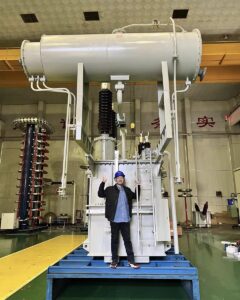Sizing transformers for Canadian homes can be confusing and risky. Choose wrong, and you might face electrical failures, safety hazards, or unnecessary expenses on oversized equipment.
To properly size a transformer for Canadian residential voltage (120V/240V), calculate the total connected load in watts, apply a demand factor based on usage patterns, and select a transformer with 25% additional capacity. For typical Canadian homes, transformers between 10-50 kVA are common, depending on the home's size and electrical demands.
 calculation](https://voltoritransformer.com/wp-content/uploads/2025/09/image-1-transformer-sizing-calculation-chart-c.png)
Getting transformer sizing right is crucial for every Canadian home. The right transformer ensures your electrical system runs efficiently and safely while keeping costs reasonable. Let me walk you through everything you need to know about sizing transformers for typical Canadian residential voltage requirements.
How Do I Calculate What Size Transformer I Need?
Homeowners often struggle with mysterious electrical issues and high energy bills. These problems frequently trace back to improperly sized transformers that can't handle actual household demands.
To calculate the transformer size you need, first list all electrical equipment and their wattage ratings, then multiply the total by 1.25 for safety margin. For example, if your connected load is 8,000 watts, you'll need at least a 10 kVA transformer (8,000 × 1.25 = 10,000 VA or 10 kVA).
 calculation transformer calculation example](https://voltoritransformer.com/wp-content/uploads/2025/09/image-2-step-by-step-transformer-sizing-calcul.png)
In my years handling transformer supply chains across Canada, I've noticed that the standard approach of simply summing connected loads often leads to oversizing. This might seem like a safe choice, but it actually results in unnecessary expenses and reduced efficiency. At Voltori Energy, we've developed a more nuanced approach that considers regional usage patterns and seasonal demands.
Let me share our detailed calculation method:
- List all electrical loads: Document every electrical device in the home with its wattage
- Apply diversity factors: Not all equipment runs simultaneously
- Lighting: 70-90% of total lighting load
- Receptacles: 50-70% of total receptacle load
- Large appliances: 70-100% depending on usage patterns
- Consider regional factors: Northern Canadian homes typically need additional capacity for heating
- Add future expansion: Leave 15-20% extra capacity for future needs
- Apply safety factor: Multiply by 1.25 for safety margin
I've found that reviewing historical consumption data alongside these theoretical calculations yields much better results than simply following textbook formulas. This approach has saved our clients significant costs while still ensuring their electrical systems remain reliable.
How Do You Size a Transformer for a Residential Building?
Many residential builders face unexpected electrical system upgrades and costly modifications because they didn't properly account for modern home electrical demands during initial transformer sizing.
To size a transformer for a residential building, calculate the total connected load (typically 100-200 VA per square meter of living space), apply a demand factor (usually 0.4-0.7 for residential), and select a transformer rated for at least 125% of this calculated demand load.

Based on my experience overseeing transformer installations across different Canadian provinces, I can tell you that residential transformer sizing requires special attention to several key factors. The traditional VA per square foot method needs significant adjustment for modern Canadian homes with their increasing number of electronic devices and potential for electric vehicle charging.
Our team at Voltori typically approaches residential building transformer sizing with these considerations:
Location-Based Sizing Considerations
| Region | Typical Load Adjustment | Reasoning |
|---|---|---|
| Northern Territories | +25-30% | Extended heating seasons, extreme conditions |
| Urban Centers | +15-20% | Higher concentration of electronics, potential EV charging |
| Coastal Areas | +10-15% | Humidity factors, corrosion protection requirements |
| Rural Areas | +20% | Need for self-sufficiency during outages |
I've learned that homes in different regions have significantly different electrical profiles. For instance, a 2,500 sq. ft. home in Nunavut might require a transformer nearly 40% larger than an identical floor plan in Vancouver due to heating demands and limited grid support.
Additionally, modern smart homes with extensive automation, home offices, and entertainment systems typically require an extra 15-20% capacity compared to standard homes. When we factor in the growing adoption of electric vehicles, future-proofing becomes essential. A single Level 2 EV charger can add 7-10 kVA to peak demand, which significantly impacts transformer sizing decisions.
What Is the Rule of Thumb for Transformer Sizing?
Homeowners and contractors often use outdated rules of thumb for transformer sizing that don't account for modern electronics, leading to undersized systems that fail prematurely or operate inefficiently.
The general rule of thumb for transformer sizing is to select a transformer rated at 125-150% of the anticipated continuous load. For residential applications, this typically means using 5-7 VA per square foot (or 50-75 VA per square meter) as a starting point before detailed calculations.
 chart](https://voltoritransformer.com/wp-content/uploads/2025/09/image-4-transformer-sizing-rule-of-thumb-chart.png)
The common "rule of thumb" for transformer sizing (125% of continuous load) serves as a starting point, but through our supply chain optimization work at Voltori, I've learned this can be refined much further. For Canadian residential applications specifically, considering harmonics from modern appliances and electronics calls for more nuanced approaches.
Modern homes contain numerous non-linear loads like LED lighting, computers, and variable-speed motors that generate harmonics. These harmonics can cause transformer heating beyond what's expected from the nominal load. Based on our field measurements, I recommend increasing the sizing factor to 135-150% for homes with extensive electronics.
Another critical factor often overlooked is the starting current of larger motors in heating/cooling systems. These inrush currents can be 6-10 times the running current, placing momentary but significant stress on transformers. In areas with extreme temperature swings like Alberta or Saskatchewan, this becomes particularly important.
Here's a more comprehensive approach I've developed for Canadian residential settings:
- Base Calculation: 125% of continuous load
- Harmonic Adjustment: +10-25% based on electronics density
- Climate Adjustment: +10% for extreme temperature regions
- Voltage Quality Adjustment: +5-15% for areas with known utility voltage fluctuations
- Future Expansion: +15-25% for growing families or anticipated technology adoption
This approach has consistently produced more reliable transformer sizing recommendations than simplified rules of thumb, saving our customers from both undersizing and excessive oversizing.
What Size Voltage Transformer Do I Need?
Many homeowners waste money on oversized transformers or risk damage with undersized units because they don't understand the specific voltage transformation requirements of their appliances and electrical systems.
For Canadian residential applications requiring 120V/240V, determine your total power needs in VA (volts × amps), then select a transformer with that minimum capacity. For a typical Canadian single-family home, voltage transformers between 10-50 kVA are common, with 25 kVA meeting most average household needs.

In my work overseeing transformer supply chains, I've noticed a concerning trend: many installers focus solely on the voltage conversion aspect without proper attention to protection features. This is particularly problematic in the Canadian context, where our grid experiences unique challenges.
Canada's vast geography means power quality varies significantly across regions. Northern and rural areas often experience more frequent voltage fluctuations than urban centers. This makes protection features in voltage transformers essential, not optional. At Voltori, I insist that all our voltage transformers include sufficient protection against these fluctuations and the extreme weather conditions that can affect power quality.
When selecting a voltage transformer specifically for Canadian homes, consider these additional factors:
Critical Selection Factors
| Factor | Consideration | Impact |
|---|---|---|
| Temperature Range | -40°C to +40°C capability | Ensures operation in Canadian climate extremes |
| Surge Protection | Enhanced protection ratings | Guards against lightning strikes common in many regions |
| Efficiency Rating | Minimum 97% at rated load | Reduces energy waste and operating costs |
| Harmonic Handling | K-Factor rating appropriate for load | Prevents overheating with modern electronics |
| Noise Rating | Below 45dB for residential areas | Ensures quiet operation in home settings |
I've found that many homeowners don't realize voltage transformers also need to handle temporary overloads. Appliance startups, particularly older air conditioners and refrigerators, can draw 3-5 times their normal operating current. For homes with aging appliances, I recommend selecting transformers with 200% momentary overload capability rather than the standard 150%.
Additionally, altitude considerations become important in mountainous regions of British Columbia and Alberta. Above 1000 meters, transformers typically need to be derated by about 0.3% per 100m above sea level due to reduced cooling efficiency in thinner air.
Conclusion
Properly sizing transformers for Canadian residential voltage requires careful calculation of loads, understanding regional factors, and planning for future needs. Don't guess—follow the guidelines I've shared to ensure safety and efficiency.
For expert guidance on custom transformer solutions for your Canadian energy projects, trust Voltori Energy's specialized engineering and local support.




